Abstract
The in vitro activity of ciprofloxacin (Bay o 9867), a new carboxyquinoline antimicrobial agent, was compared with those of norfloxacin, nalidixic acid, and several other oral and parenteral antimicrobial agents. Ciprofloxacin was substantially more active than nalidixic acid or cinoxacin against all gram-negative bacteria tested. Virtually all strains of Enterobacteriaceae were inhibited by the new drug at concentrations of less than or equal to 0.125 micrograms/ml. Ciprofloxacin was more active than norfloxacin against Klebsiella sp., Enterobacter sp., and Serratia marcescens, and it was the most active agent against Pseudomonas aeruginosa (MIC90, 0.5 micrograms/ml). The new drug also demonstrated significant activity against gram-positive cocci, inhibiting all strains of staphylococci at concentrations of less than or equal to 1.0 microgram/ml. Ciprofloxacin was bactericidal at concentrations near the MIC against most isolates tested. Although stepwise increases in resistance were seen with Escherichia coli and P. aeruginosa during serial passage on plates containing incremental concentrations of the drug, significant resistance did not emerge during incubation of strains in broth containing concentrations of ciprofloxacin above the MBC.
Full text
PDF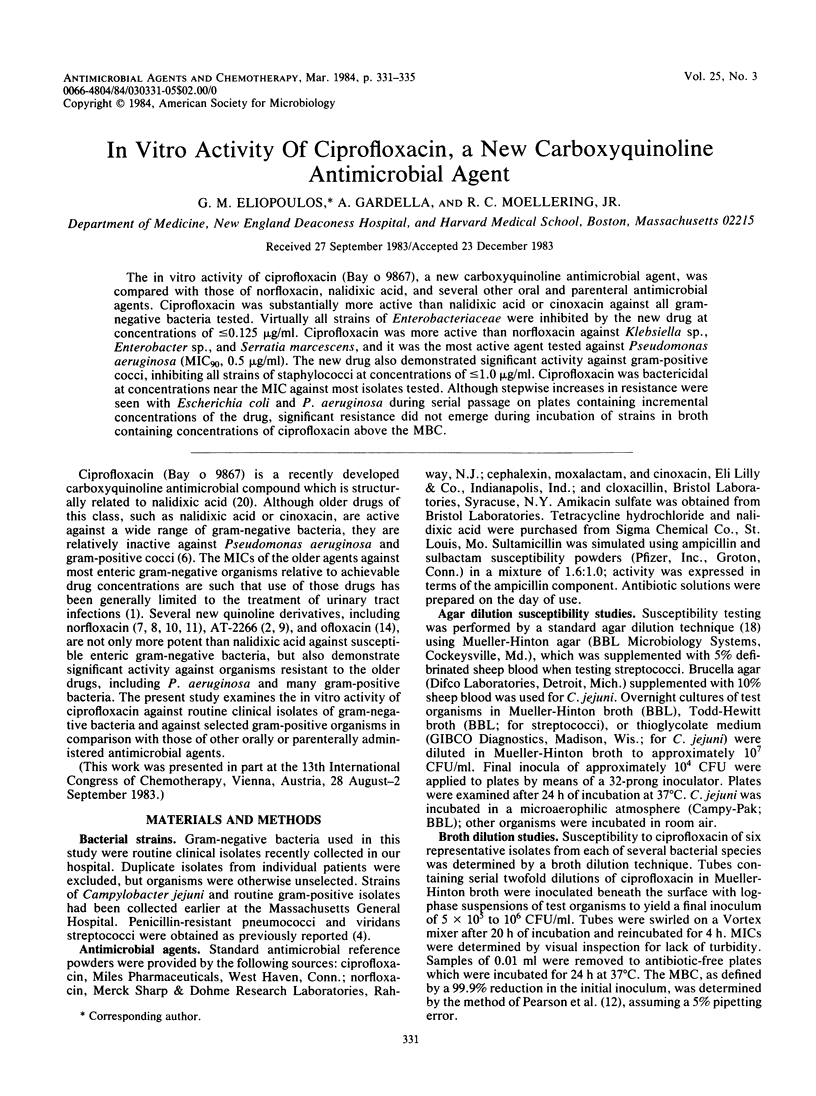
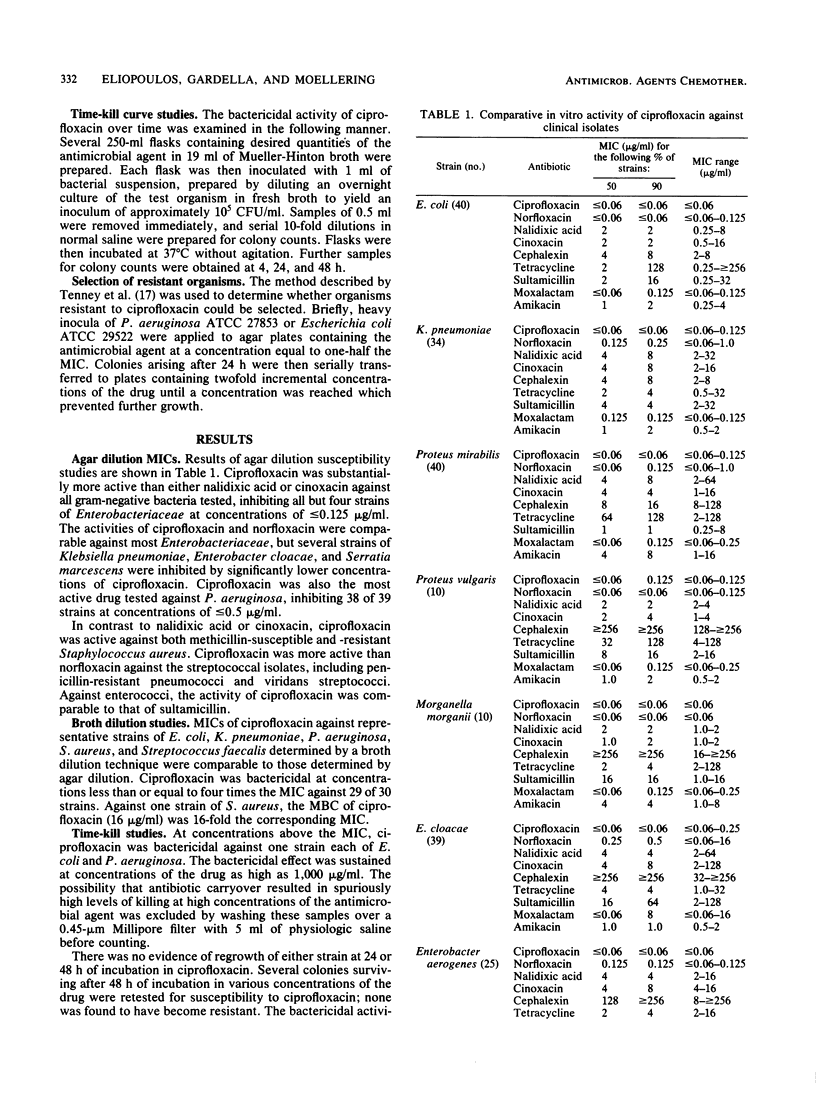
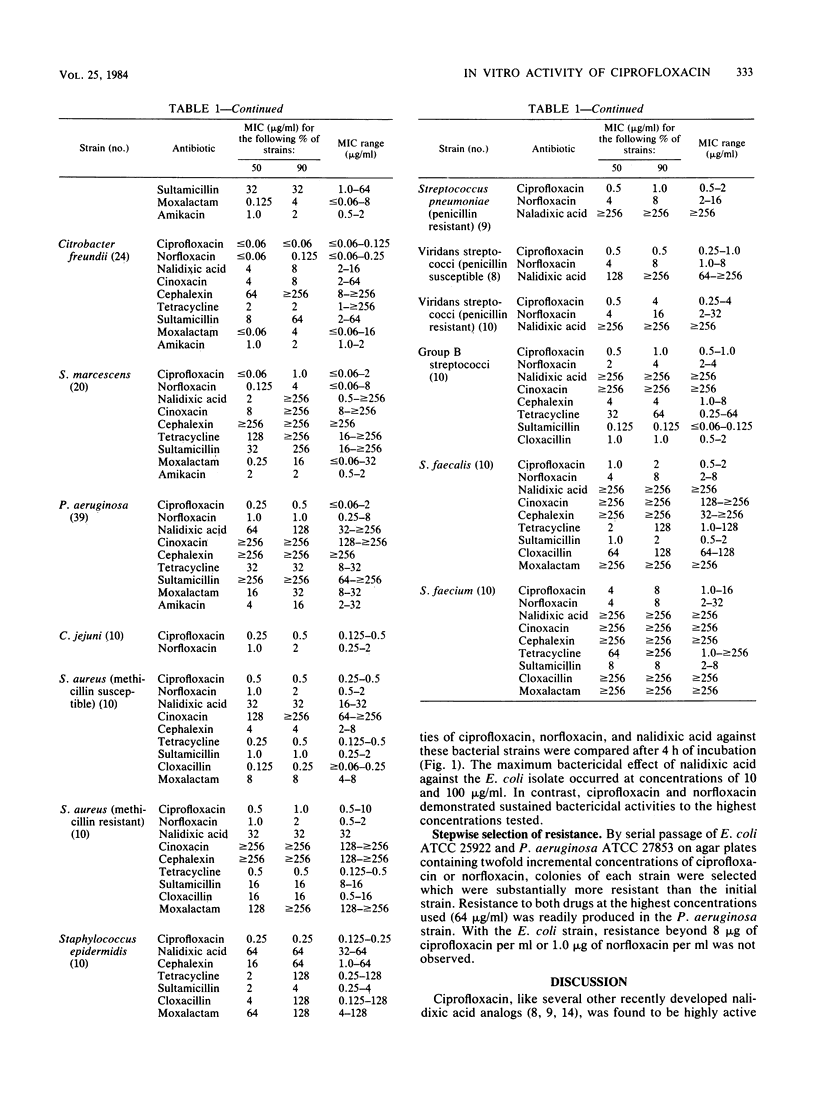
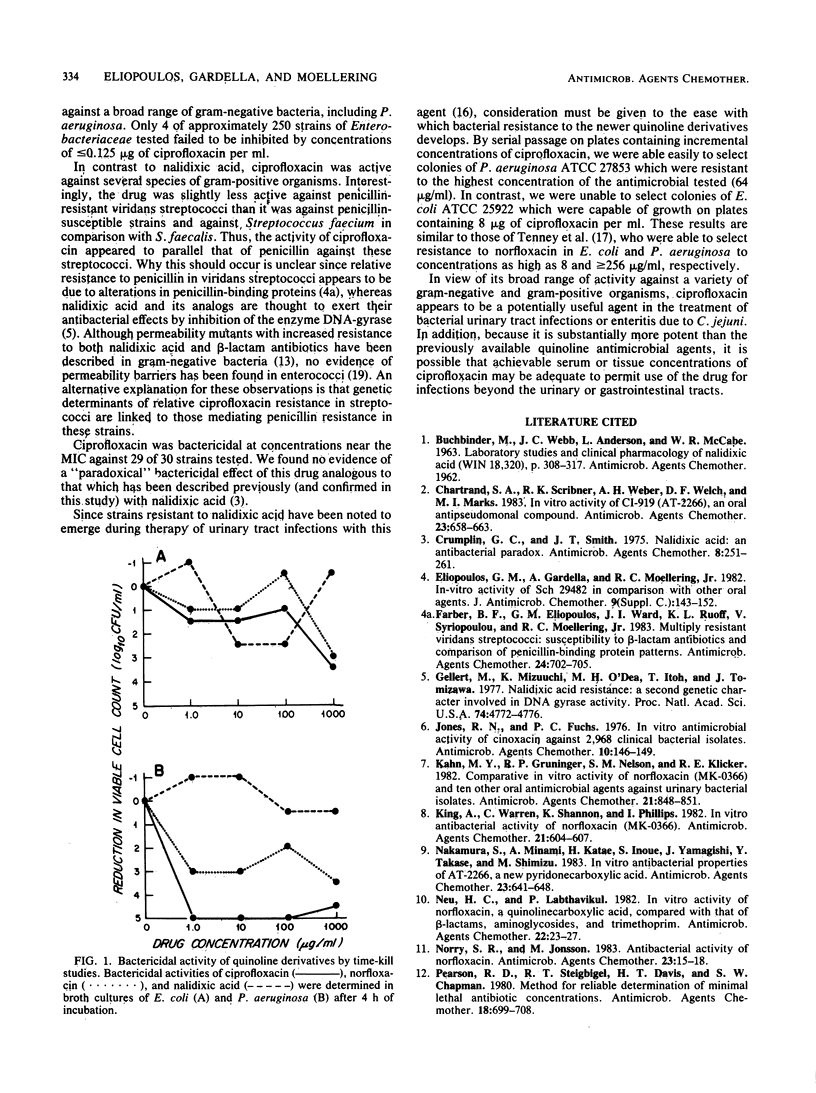
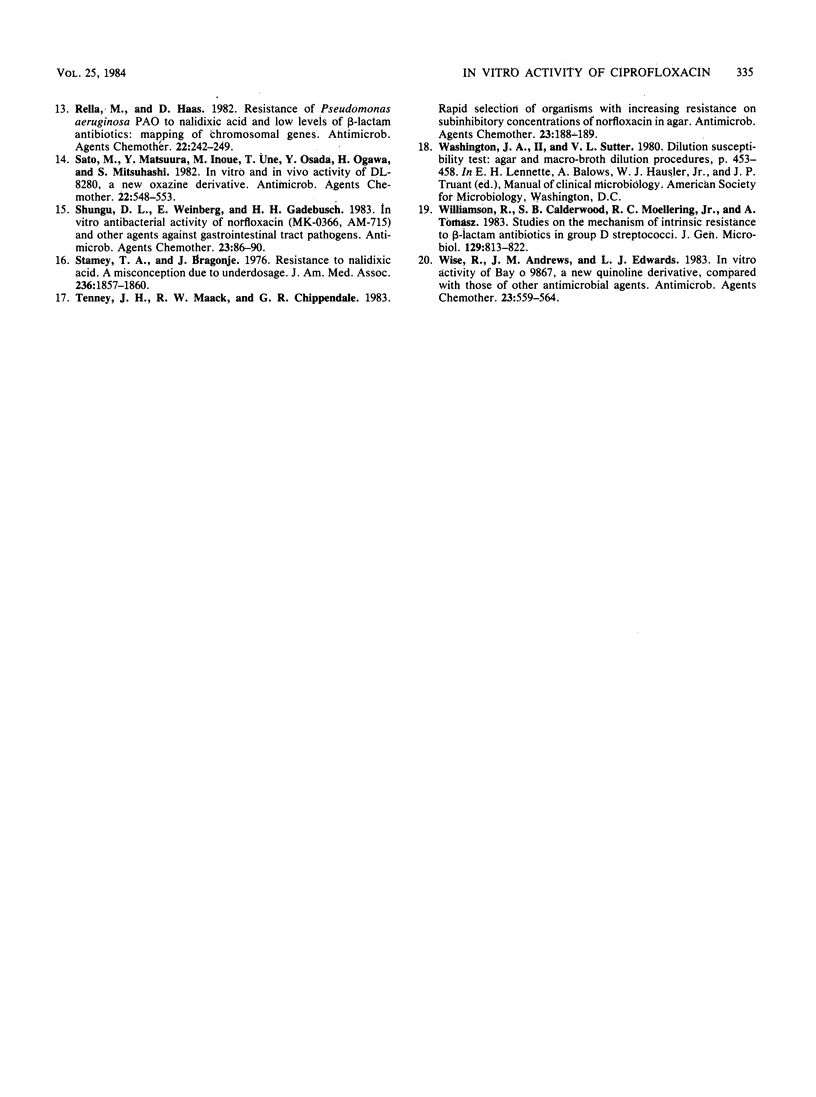
Selected References
These references are in PubMed. This may not be the complete list of references from this article.
- Chartrand S. A., Scribner R. K., Weber A. H., Welch D. F., Marks M. I. In vitro activity of CI-919 (AT-2266), an oral antipseudomonal compound. Antimicrob Agents Chemother. 1983 May;23(5):658–663. doi: 10.1128/aac.23.5.658. [DOI] [PMC free article] [PubMed] [Google Scholar]
- Eliopoulos G. M., Gardella A., Moellering R. C., Jr In-vitro activity of Sch 29482 in comparison with other oral antibiotics. J Antimicrob Chemother. 1982 Feb;9 (Suppl 100):143–152. doi: 10.1093/jac/9.suppl_c.143. [DOI] [PubMed] [Google Scholar]
- Farber B. F., Eliopoulos G. M., Ward J. I., Ruoff K. L., Syriopoulou V., Moellering R. C., Jr Multiply resistant viridans streptococci: susceptibility to beta-lactam antibiotics and comparison of penicillin-binding protein patterns. Antimicrob Agents Chemother. 1983 Nov;24(5):702–705. doi: 10.1128/aac.24.5.702. [DOI] [PMC free article] [PubMed] [Google Scholar]
- Gellert M., Mizuuchi K., O'Dea M. H., Itoh T., Tomizawa J. I. Nalidixic acid resistance: a second genetic character involved in DNA gyrase activity. Proc Natl Acad Sci U S A. 1977 Nov;74(11):4772–4776. doi: 10.1073/pnas.74.11.4772. [DOI] [PMC free article] [PubMed] [Google Scholar]
- Jones R. N., Fuchs P. C. In vitro antimicrobial activity of cinoxacin against 2,968 clinical bacterial isolates. Antimicrob Agents Chemother. 1976 Jul;10(1):146–149. doi: 10.1128/aac.10.1.146. [DOI] [PMC free article] [PubMed] [Google Scholar]
- Khan M. Y., Gruninger R. P., Nelson S. M., Klicker R. E. Comparative in vitro activity of norfloxacin (MK-0366) and ten other oral antimicrobial agents against urinary bacterial isolates. Antimicrob Agents Chemother. 1982 May;21(5):848–851. doi: 10.1128/aac.21.5.848. [DOI] [PMC free article] [PubMed] [Google Scholar]
- King A., Warren C., Shannon K., Phillips I. In vitro antibacterial activity of norfloxacin (MK-0366). Antimicrob Agents Chemother. 1982 Apr;21(4):604–607. doi: 10.1128/aac.21.4.604. [DOI] [PMC free article] [PubMed] [Google Scholar]
- Nakamura S., Minami A., Katae H., Inoue S., Yamagishi J., Takase Y., Shimizu M. In vitro antibacterial properties of AT-2266, a new pyridonecarboxylic acid. Antimicrob Agents Chemother. 1983 May;23(5):641–648. doi: 10.1128/aac.23.5.641. [DOI] [PMC free article] [PubMed] [Google Scholar]
- Neu H. C., Labthavikul P. In vitro activity of norfloxacin, a quinolinecarboxylic acid, compared with that of beta-lactams, aminoglycosides, and trimethoprim. Antimicrob Agents Chemother. 1982 Jul;22(1):23–27. doi: 10.1128/aac.22.1.23. [DOI] [PMC free article] [PubMed] [Google Scholar]
- Norrby S. R., Jonsson M. Antibacterial activity of norfloxacin. Antimicrob Agents Chemother. 1983 Jan;23(1):15–18. doi: 10.1128/aac.23.1.15. [DOI] [PMC free article] [PubMed] [Google Scholar]
- Pearson R. D., Steigbigel R. T., Davis H. T., Chapman S. W. Method of reliable determination of minimal lethal antibiotic concentrations. Antimicrob Agents Chemother. 1980 Nov;18(5):699–708. doi: 10.1128/aac.18.5.699. [DOI] [PMC free article] [PubMed] [Google Scholar]
- Rella M., Haas D. Resistance of Pseudomonas aeruginosa PAO to nalidixic acid and low levels of beta-lactam antibiotics: mapping of chromosomal genes. Antimicrob Agents Chemother. 1982 Aug;22(2):242–249. doi: 10.1128/aac.22.2.242. [DOI] [PMC free article] [PubMed] [Google Scholar]
- Sato K., Matsuura Y., Inoue M., Une T., Osada Y., Ogawa H., Mitsuhashi S. In vitro and in vivo activity of DL-8280, a new oxazine derivative. Antimicrob Agents Chemother. 1982 Oct;22(4):548–553. doi: 10.1128/aac.22.4.548. [DOI] [PMC free article] [PubMed] [Google Scholar]
- Shungu D. L., Weinberg E., Gadebusch H. H. In vitro antibacterial activity of norfloxacin (MK-0366, AM-715) and other agents against gastrointestinal tract pathogens. Antimicrob Agents Chemother. 1983 Jan;23(1):86–90. doi: 10.1128/aac.23.1.86. [DOI] [PMC free article] [PubMed] [Google Scholar]
- Stamey T. A., Bragonje J. Resistance to nalidixic acid. A misconception due to underdosage. JAMA. 1976 Oct 18;236(16):1857–1860. [PubMed] [Google Scholar]
- Tenney J. H., Maack R. W., Chippendale G. R. Rapid selection of organisms with increasing resistance on subinhibitory concentrations of norfloxacin in agar. Antimicrob Agents Chemother. 1983 Jan;23(1):188–189. doi: 10.1128/aac.23.1.188. [DOI] [PMC free article] [PubMed] [Google Scholar]
- Williamson R., Calderwood S. B., Moellering R. C., Jr, Tomasz A. Studies on the mechanism of intrinsic resistance to beta-lactam antibiotics in group D streptococci. J Gen Microbiol. 1983 Mar;129(3):813–822. doi: 10.1099/00221287-129-3-813. [DOI] [PubMed] [Google Scholar]
- Wise R., Andrews J. M., Edwards L. J. In vitro activity of Bay 09867, a new quinoline derivative, compared with those of other antimicrobial agents. Antimicrob Agents Chemother. 1983 Apr;23(4):559–564. doi: 10.1128/aac.23.4.559. [DOI] [PMC free article] [PubMed] [Google Scholar]


